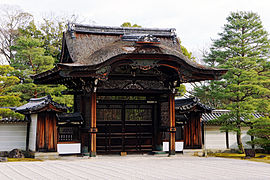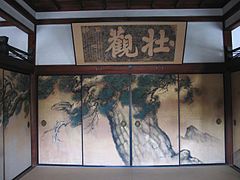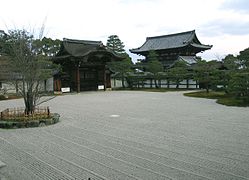Ninna-ji

The Ninna-ji ( Japanese 仁 和 寺 ) is a large Buddhist temple complex of the Shingon-shū in the northwest of the Japanese city of Kyoto . It used to be called the "Old Imperial Palace of Omuro". The temple is the seat of the Omuro School of Ikebana .
history
The Ninna-ji was built in 888 by the Uda -tennō ( 宇 多 天皇 ; 867-931). His predecessor Kōkō had started with the plant , but he died before completion. Uda abdicated at the age of 33 and after his abdication, Uda withdrew here in 899 and lived as a monk as in the later Insi system. He had been ordained a monk by the Shingon priest Yakushin ( 益 信 ; 827-906) at the Tō-ji . The line of esoteric Buddhism established in this way at Ninna-ji later became known as the Hirosawa School.
According to Uda, the head of the temple was always the first or second son of the respective emperor's highest priest until the Meiji period. The temple was thus the center of pro-imperial forces, which were often directed against the Fujiwara . Under Shukaku -hosshinnō ( 守 覚 法 親王 ; 1150-1202), son of Go-Shirakawa -tennō, the temple became one of the most important centers of esoteric Buddhism in Japan.
In the course of the social decline of the nobility during the Muromachi period , the Ninna-ji lost prestige. It was completely destroyed in the Ōnin War (1467–77). After that, the temple moved to the Narabigaoka Hill and had a miserable existence for 150 years. At the beginning of the Edo period, however, the 21st head of the temple, Kakushinhō Shinnō, managed to get the support of Tokugawa Iemitsu for a reconstruction. Between 1641 and 1646, some buildings were transferred from the imperial residence. In 1887 a fire destroyed the abbots' quarters, which were given their current shape in 1913.
The temple complex
( ⦿ = national treasure , ◎ = important cultural asset of Japan )
- You enter the temple in the south through the ◎ Great South Gate ( 南 大門 , Nandaimon), also called Niō-mon ( 二 王 門 ). It was donated by Tokugawa Iemitsu. The gate, built between 1637 and 1644, is designed as a nijū-mon . Along with the entrance gates of the Chion-in and the Nanzen-ji, it is one of the three great gates of Kyoto.
- On the left side there is the abbot's quarters separated by a wall, the first gate of which is in the yakui style. The second gate to the abbot's quarters on this side is designed as a Karamon. After it burned down in 1887, it was replaced in 1913 by a replica by the architect Kameoka Suekichi (1865–1922). In the Shiroshoin of the abbot's quarters, the reception hall rebuilt for guests after a major fire in the Meiji period, sliding doors are painted by Fukunaga Seihō (1882–1961).
- ◎ Hitōtei ( 飛 濤 亭 ) and ◎ Ryōkakutei ( 遼 廓 亭 ) are two teahouses in the abbot's quarters from the late Edo period.
Rear temple complex:
- ◎ Middle Gate ( 中 門 , Chūmon), from the beginning of the Edo period.
- The Omuro cherry trees ( 御 室 の 桜 ), low and wide, are registered as a “national beautiful sight” ( 国 名勝 ).
- The ◎ five-story pagoda ( 五 重 塔 ), 36 m high, dates from the Kan'ei period (1624–1644) and is a good example of late pagoda construction , along with the Tō-ji pagoda, which is about the same age . What is striking is the low level of recirculation of the floor overhang.
- ◎ Kannon-dō ( 観 音 堂 ) (Edo period) on the left and right a shrine complex Kujo Myōjin ( 九 所 明 神 ) consisting of three buildings .
- ⦿ The main hall ( 金堂 , Kondō) was lost twice by fire. The current building dates from the early Edo period and was moved from the Imperial Palace, where it was a residential building. Originally it was covered with cedar bark, after the move it was given a tiled roof. The hall is flanked on the right by the sutrenspeicher and on the left by the drum tower, both Edo period.
- Left behind is the Miedō ( 御 影 堂 ), Momoyama time, i.e. the hall in which the temple founder is venerated. It is executed in the Hōgyō form .
Temple treasures
The following are registered as national treasures:
- The wooden sculptures of Seated Amida Nyorai with companions, Seated Yakushi Nyorai, both from the Heian period.
- The scroll with the figure of Kujaku Myōō (Northern Sung), who is especially venerated in esoteric Buddhism.
- Various collections of scriptures from the Heian and Kamakura periods.
In addition, the temple has a large number of important cultural assets .
In 1994, Ninna-ji was with other historic sites of ancient Kyoto by the UNESCO for World Heritage Historic Kyoto (Kyoto, Uji and Otsu Cities) appointed.
gallery
literature
- Temple Brochure (Japanese), 2004. 24 pp.
- Yamamoto, Jirō: Kyoto-fu no rekishi sampo (chu). Yamakawa Shuppan, 1998. ISBN 978-4-634-29560-5 . P. 83ff.
Web links
- Official website of the Ninna-ji - Japanese
- Kyōto Prefecture Information Center - English
- Information offered by the city of Kyoto - English
- Temple Ninna-ji at Culture-in-Asia: Part 1 with description - Part 2 - Part 3 - Part 4 - Part 5 - Part 6 - Part 7 - Part 8 - Part 9
Coordinates: 35 ° 1 ′ 52 " N , 135 ° 42 ′ 50" E







